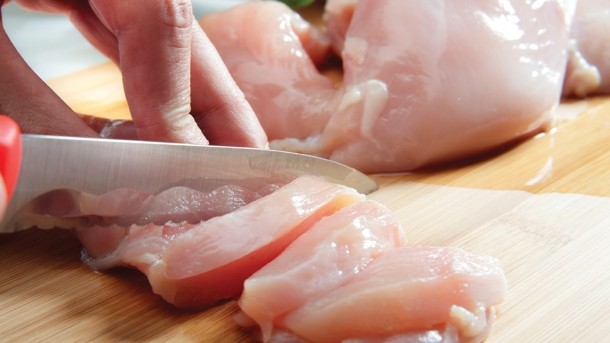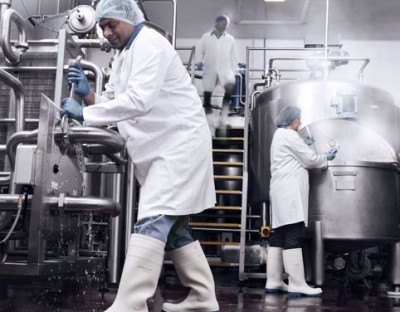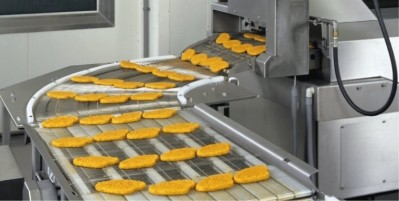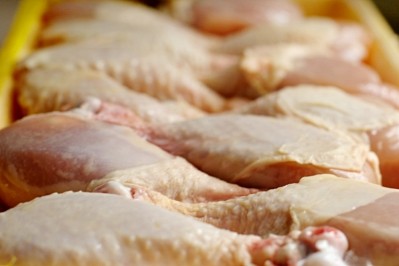Don't play chicken with campylobacter

The problem of campylobacter contamination has proved a tough nut to crack for the food industry, but the bacterium itself is actually pretty weedy. Simply buying frozen meat or freezing it at home could eliminate 90% of colony forming units (cfus), according to food safety experts. Even so, the tendency of British consumers to opt for fresh, chilled food over frozen and the sheer ubiquity of campylobacter means that it currently causes more cases of food poisoning in the UK than any other organism, killing more than 100 people each year.
“Campylobacter is not so difficult to kill,” says Dr Karen Middleton-Gell, technical director of the Society of Food Hygiene & Technology (SoFHT). “Cross-contamination is the much bigger problem. As an organism, it’s naturally found living quite happily in the gut of poultry and pork.”
One of the Food Standards Agency’s (FSA’s) top priorities for food safety is to reduce the number of birds that hit supermarket shelves with a cfu count higher than 1,000 per gram, which forms part of its new strategy for 2015–20.
“Our target is to reduce that highest level of contamination, which are the birds most likely to make people ill,” says an FSA spokesman. “We’ve set this target because, without a vaccine, you’re never going to get to zero. Reducing levels below 1,000cfu/g is practical progress.”
Campylobacter is not a new issue for the industry, which has already introduced some solutions to help mitigate cross-contamination, such as leak-free packaging and cook-in-the-bag poultry products. And last June, Moy Park announced research into biosecurity and good practice initiatives totalling £1M across 600 poultry farms in Northern Ireland and England.
However, consumer awareness of campylobacter ratcheted up considerably in November, when the FSA published the half-year results from a year-long survey of supermarket chicken, ‘naming and shaming’ the retailers with the most widespread and/or heaviest contamination.
Asda came off worst, with 28% of its chickens having skin contaminated at 1,000cfu/g or higher. Other supermarkets showed a lower incidence of contamination at this level, although none emerged from the process with a clean bill of health, with 70% of birds on average showing some degree of contamination.
Technological fixes (Return to top)
Yet the situation may be about to change, with major trials underway for technological fixes that processors and retailers hope might prove transformational.
The first is rapid surface chilling (RSC), which is being developed by Bernard Matthews and BOC, part of The Linde Group. Trials are currently moving to the industrial scale, but those already carried out have been extremely promising. The system relies on spraying nitrogen vapour at between -100°C and -150°C at the skin of carcasses, so that it cools the outer membrane without freezing the meat.
Jeremy hall, technical director with Bernard Matthews, says: “The law says you can drop the temperature of the skin but you cannot freeze the meat and then sell it as chilled, so we’ve spent over a year modifying the prototype to meet these criteria. Probes show that nothing below the skin falls below -2°C. It doesn't cause freezer burn on the skin because it all happens so quickly, so there are no visual or organoleptic changes afterwards.
“Success is the FSA target of 90% of birds below 1,000cfu/g or a one log reduction, which we've achieved, and we're hoping to find ways to take that even higher.”
The other main contender currently under test is the SonoSteam process, which combines ultrasound and superheated steam to disinfect carcasses inside and out. The process is the brainchild of Danish company Force Technology and is being trialled in the UK by poultry processor Faccenda Foods, which also hosted some of the RSC trials.
Hall says that blasting chickens with steam can risk impacting on the quality, but notes that the SonoSteam developers say they have upgraded their systems to overcome any earlier teething troubles. Hall also says that the SonoSteam system offers a smaller footprint than RSC. This could prove to be important since the aim would be to slot any new system into existing facilities with the minimum disruption.
Cost is another major consideration for any solution aimed at the mass market and the two competing technologies currently stack up at around two pence per bird for SonoSteam, according to a Faccenda spokesman, and between four and six pence per bird for RSC, although Hall says that the price of the chilling technology is likely to come down.
As for how well the two systems deliver on the contamination reduction target (90% of birds below 1,000cfu/g), it’s extremely doubtful whether either set of trials will be delivering at an industrial scale in time to impact on the full-year results of sampling by the FSA, which will be complete at end of February.
It’s no coincidence that both of the technical fixes currently under scrutiny for carcass disinfection are based on thermal processes, since the EU currently does not permit biocidal washes to be used directly on the meat.
Antimicrobial washes (Return to top)
“Under European law antimicrobial washes aren’t allowed,” says the FSA spokesman. “Early on there was some trialling with lactic acid and that was approved for beef.”
“Industry has been talking about [carcass washing] less recently,” he continues, noting that one likely reason is that thermal processes do not face the same regulatory hurdles as solutions based on biocidal washes. “If an innovative intervention doesn't require fresh EU approvals it’s going to save a lot of time.”
However, that doesn’t stop companies that are promoting competing approaches from urging processors and regulators in the EU to think again about these alternative disinfection solutions, some of which are already being used in large markets elsewhere in the world.
Alternative solutions (Return to top)
For instance, Eco Green Envirolyte UK is one of an international network of companies promoting neutral pH electrolysed water with the Anolyte ANK solution, which is already approved by the US Food and Drug Administration for carcass washing in the States. “Our product can be used to dose drinking water because it is proven to be safe for human consumption,” says director John Ware. “If we can consume it, then surely it is safe to disinfect food products and help prevent campylobacter within the poultry farming environment.”
While the company is hoping that it will eventually win approval to deploy Anolyte ANK for carcass washing, Eco Green is initially planning to start testing it further up the supply chain in British farms, both as an additive in drinking water for the birds and to clean the areas where they defecate.
Meanwhile, a solution called ‘hypochlorous acid water’ is approved for use throughout the poultry processing chain in Japan, according to Bola Lafe, founder and md of Acquaint. The firm wants to offer its own version of this slightly acidic electrolysed water to UK producers. “In Japan, hypochlorous acid water at very specific concentrations (identical to Aquaint) is approved by Japan’s Ministry of Health, Labour & Welfare as both a ‘food additive’ and a ‘food sanitiser’. It is also approved by the Japanese Ministry of Agriculture, Forestry & Fisheries as an effective means of managing poultry production sanitation,” says Lafe.
Lafe claims that Acquaint could be safely used for cleaning carcasses and equipment throughout the manufacturing process and the company is in the “very early stages” of exploring the routes to possible approval in Europe: “It has passed UK potable water tests and does not affect the colour, taste or texture of the poultry.”
No magic bullet (Return to top)
While any or all of these technological approaches might prove useful, there’s unlikely to be any magic bullet that will solve the campylobacter challenge entirely. “This organism isn’t going to go away. Good hygiene has to be part of the system,” says SoFHT’s Middleton-Gell. “We are better off looking at better practices all down the chain, not just waiting till the end to disinfect the carcasses. Measures like good handwashing, cleaning and leak-proof packaging have an important role to play.”
With this in mind, recent weeks have seen cleaning and hygiene validation specialists highlighting how their products can help in the fight against campylobacter. For instance, CrossCheck is a rapid test system just launched by Hygiena that provides a quick check for contamination of raw meat or poultry.
CrossCheck measures an enzyme that is present in raw meat and fish. It is not a test for specific bacteria. The enzyme measured is destroyed by cooking, so the test can also be used to verify cooking processes.
















